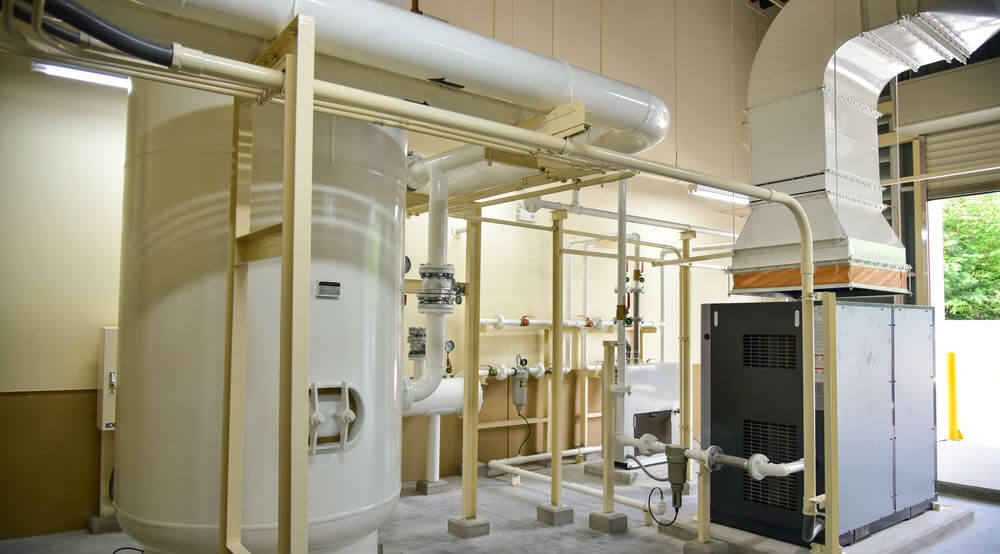Pressure Dew Point in Compressed Air: What Is It and How to Measure It
May 26, 2020
The generation of compressed air used in industrial processes like heat generation, cooling, and tool operations produces significant amounts of water vapor. This inevitable by-product generated during air compression might be harmless in small quantities, but an unchecked accumulation of water vapor can damage sensitive industrial equipment or even alter the quality of finished products.
As a result of the damaging effects of excess water accumulation in compressed air systems, plant managers must ensure their personnel understands how to properly monitor the dew point of compressed air. Personnel should also understand effective measures to keep water vapor levels at an acceptable level.

What Is Dew Point of Compressed Air?
The dew point of compressed air can be defined as the temperature at which water vapor suspended in the air can start condensing into liquid form at an equal rate as it is evaporating. This fixed temperature is the point at which the air is fully saturated with water and can no longer hold any more vaporized water except some of the vapor it contains condenses.
What Is Dew Point Temperature of Compressed Air?
The dew point temperature of compressed air is the temperature at which water begins to condense out of the air into a liquid form. This temperature varies between compressor systems and is usually measured between 50°F to 94°F.
Specific compressed air moisture sensors can be installed to monitor instrument air dew point temperatures and alert operators when it exceeds a pre-programmed level. Continuous dew point temperature monitoring is critical to preserving moisture-sensitive equipment components from damage.
Differences between Pressure Dew Point and Atmospheric Dew Point
Although it is easy to confuse the two terms, there is a significant difference in the measured pressure dew point and atmospheric dew point. While one occurs naturally, the other is induced by a compressor system.
Pressure Dew Point
This refers to the temperature of gases subjected to a pressure that exceeds the normal atmospheric pressure level. This increased pressure level is usually associated with an air compression system and is relevant to operators seeking to protect sensitive equipment from the damaging effects of accumulated moisture.
Atmospheric Dew Point
The atmospheric dew point is the temperature at which the water vapor content of air reaches a saturation point without the influence of external pressure. The atmospheric dew point temperature is measured under normal atmospheric pressure conditions. Atmospheric dew point is frequently employed by pilots and meteorologists to forecast weather patterns.
Why Does Dew Point Measurement Matter for Industrial Settings?
Measuring dew point in industrial settings is critical to ensuring that sensitive equipment does not undergo corrosive damage and the quality of end products is preserved. The moisture precipitated during air compression processes has detrimental effects on equipment including:
- Corrosion that degrades moving parts as moisture-related impurities will remove lubricants
- Condensed water freezing within flow lines will hamper machinery functionality
- Rust on affected equipment can cause control failure with erroneous readings
The overall effect of unchecked moisture accumulation is increased spending on repairs and loss of valuable revenue from avoidable downtime.
Air Dew Point Instrument Requirements
To effectively measure air dew points, industrial operators that use compressed air systems must consider the following key requirements:
- Compulsory and regular use of the appropriate measuring devices
- Sensor installation and calibration conducted by trained experts
- Proper training of personnel on accurately interpreting dew point monitoring equipment

Typical Range of Instrument Air Dew Points
Depending on the conditions air is subjected to, the temperature range of an instrument air dew point can vary significantly. The saturation point of water vapor in the air can be attained at ambient temperatures in some cases whereas, under other conditions, the air dew point might fall as low as 80°F or more below zero.
For air compression systems that incorporate an air dryer unit, a heat exchanger will efficiently eliminate condensation from the air, thus maintaining dew point at a level no lower than 41°F.
In processes where desiccant air dryers are used, the saturation temperature of the compressed air can lower the dew point up to -40°F.
How to Measure Dew Point in Compressed Air
Accurate compressed air testing and dew point measurement is done using a specialized dew point sensor which can be incorporated into air compression system setups. Some air dryers have in-built sensors that provide continuous data on the saturation level of the compressed air flowing through it. These sensors require minimal adjustments and can function effectively year-round on a single calibration check.
Using Air Dryers to Reduce the Effect of Pressure Dew Point
Efficient air-drying systems can provide industrial process operators with significant control over moisture levels within their air compression units. Heatless desiccant dryers and membrane dryers can reduce the pressure dew point to as low as -100°F.
GENERON Has Air Drying Solutions to Improve Your Process
At GENERON, we are committed to providing our customers with the best air-drying solutions for compressed air generation processes. Our services are aimed at helping our clients cost-effectively realize maximum industrial productivity.
Contact us online today for more information on how our air-drying equipment can optimize your compressed air processes.
